For almost as long as I’ve been in the upper grades of school as well as my adult years, student teacher ratio has always been a topic of discussion. Because I attended a small private school from 7th-12th grade, it was always a subject to capitalize on the advantages of being in a small private school.
Then as an adult, student teacher ratio was a hot topic because of the political attention it was receiving. School funds heavily depended on student teacher ratio and how much money a school district could receive based on those numbers. It was also a hot topic in schools that had lower numbers because it was a way to set themselves apart as better.
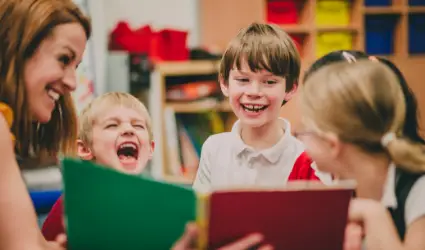
So what is the average student teacher ratio and what does that really mean for school functionality? Even more importantly, exactly how is that ratio number calculated and what does that mean for your classroom in particular? You cannot change the number of students you are assigned.
So regardless of that number, how do you make that ratio work for your class in a way that feels like a low ratio? I did some research and compared that to my experience of teaching classes that ranged from 7 students up to 25 students. What I found is that the student teacher ratio is not as dismal as it sometimes seems. And there are some great ways to function in your classroom to give it a “smaller” feel. Read on to find out more.
Table of Contents
How The Student Teacher Ratio is Determined
Researchers compile the information they receive into a direct ratio of teachers to students. This sounds pretty straightforward until you realize that the number of teachers is based on all of the teachers in a school and not just the classroom teachers.
This could include librarians, school counselors, speech therapists, P.E. teachers, art teachers, and any other teacher that is hired by the school district but doesn’t necessarily have their own class of students. Also, in the case of disabled students, most school districts have a 1:1 student teacher ratio policy. That definitely affected the numbers here.
Because of this fact, the number does get skewed by a certain amount. Because every school district’s staffing policy is different, you will need to estimate this variable to get a closer ratio to reality.
Student Teacher Ratio: Why There May be More Than Meets the Eye
While it is pretty easy to determine the averages of student teacher ratio in classrooms across America as well as a close estimate of that number in just about every class based on registration policy, there is much more to the story than just numbers.
There are many variables that cause a class to be amazing or terrible. And the number of students compared to the number of teachers is not always to blame for a bad class or credited for a good class. There are really good large classes and really bad small classes.
And the bottom line is that as a teacher, there is literally nothing you can do about the class size you are assigned. You can only do the best job with what you have been given.
Some of those other variables are as follows:
- Teacher experience
- Ability of the teacher to relate to the students
- Amount of resources available to students and teachers
- Parental involvement
- Self motivation of teachers as well as students
To be sure, these variables can be tied to student teacher ratio. More experienced teachers may not want to work in schools with larger ratios. But on the flip side, experienced teachers may love working with a larger ratio.
Another example would be parental involvement. Most smaller private schools will have more active parental involvement. When parents are paying for their children’s education, they tend to be more invested in their day-to-day educational details.
There is one thing that does seem to bear out as directly related to larger student teacher ratios. Lower income areas are often not able to hire more teachers to shrink that ratio. And that usually means fewer resources as well.
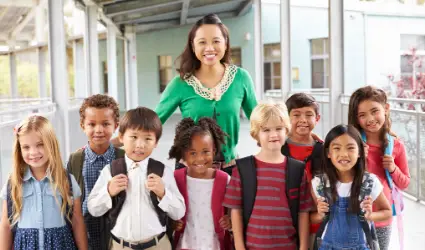
Larger Ratio is Not Always a Bad Thing
The bottom line here is that a larger student to teacher ratio does not necessarily guarantee a poorer outcome in the classroom experience. There are teachers that have done an amazing job with a larger class size. And there are parents that are heavily invested in their kids’ education, regardless of class size or socio-economic status. And finally, there are resources (many free) virtually everywhere if one is willing to look hard enough.
Student Teacher Ratio State by State
The national student teacher ratio is 16:1. And the vast majority of states fall pretty close to this national average.
The state results actually surprised me. I had always made the assumption that larger states with large cities would have way worse numbers. But that did not bear out in the results. I broke them down into 5 charts of 10 states each to make it easier for you to digest.





Unpacking These Bizarre Figures
Some of these numbers honestly seem quite skewed and odd, like the numbers that give a certain amount of students and zero teachers. And then there were some ratios that had less than 2 students per teacher. We know that there really aren’t any classrooms in America that have those kinds of numbers, so I will insert my shrug here.
I also want to note that my source for this information was the National Center for Education Statistics, which identifies itself as the primary federal entity for collecting and analyzing data related to education. And indeed, they do own a government URL.
And finally, I did find one website that had figures for the 2020 school year. But those figures did not remotely come close to the figures already placed here. And while it was the top search on Google, they did not credit sources for their figures.
So because I had no idea where those figures came from and because they were so different than my established numbers, I held off on placing the new figures until I can get some verified numbers and sources.
What This Means for You and Your Students
So what does this actually mean for you and your students? Does it automatically mean that your classroom is doomed to failure? Not at all!
What it does mean if you have a large number of students in your class, and maybe even no assistant, that you will have more prep work in many activities.
Crafts and other supplies that you have to prepare for each student will be more difficult. But there is nearly always a parent or two that is eager to help in this area. Find those parents and use them! They will appreciate that you did that for their child’s class!
Also, students in higher grades that have finished their work can be teacher assistants. If your school does not have a program to organize this, consider speaking to administration about it. It is a wonderful program for teachers, younger students, and older students as well. Everybody benefits!
On the flip side, worksheets, games with teams, and most other classroom activities will not suffer for the higher numbers.
The Engagement Factor
One thing that is critical that you will need to keep in mind is how you relate to the students. It will undoubtedly be harder to relate to each student when you have the same amount of hours every day as smaller classes, but more students to split that time between. There are certainly creative workarounds for this. You do have to be on your toes, though.
Make sure that you are engaging with all of your students at some point during the day. You will have to seek out those students that like to hide in the crowd. (I was definitely one of those kids!) And be careful not to let the students who like attention demand more of your time than you can afford to give them. But make sure they get the amount that they need.
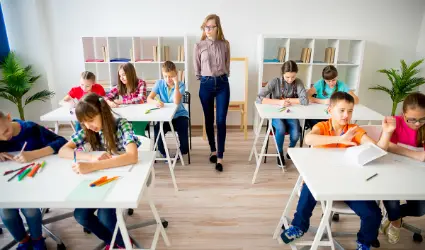
How to Make Your Classroom Feel Like it Has a Lower Student Teacher Ratio
There are lots of ways to make your large class feel smaller and more personal. These principles will also work well with small classrooms.
Smaller Groups
The first principle is to break your class up into smaller groups. This is already done in differentiated instruction, which is a popular method used in many American classrooms. I have an article here if you would like to know more specifics.
This allows students to work together in a more comfortable setting. Introverted students will be more willing to speak out. And in smaller groups, there will be fewer students who are dominating the conversation/teamwork.
Enlist Helpers
The second principle is one that I mentioned briefly above. The teacher enlists help to break up the prep work and guidance of extra groups produced by the larger numbers. That help can come in many forms. If your school is not able to add a teacher’s aide or assistant to your class, there are still several options:
- Older students in the school that have completed their own work
- College students looking for community service hours to complete
- Parents that are eager to help
- Other student leaders in your own classroom
- Homeschool students that are looking for community service hours.
I’m sure there are more options here, but this list will get you started.
Take a Break
The third principle feels like a deal breaker at first because teachers are already stretched so thin on time in the classroom. But spending just a little bit more downtime in the class for the students to breathe and take in what is going on around them can actually be a time-saver in the long run.
Most of us as adults have experienced burnout. No matter how hard we work toward that deadline, sometimes the best thing to do is walk away for a bit and then come back when you have had a chance to refresh.
The same holds true for students. Sometimes just giving them a breather will allow them to decompress just enough to get back to the work at hand without the teacher feeling like she’s got to move mountains to get the job accomplished.
Putting it in Perspective
While there are many classrooms in America that seem to have a less than optimal number of students, the truth is that the higher number is usually not so significantly higher that it becomes impossible.
What it usually boils down to is one extra group or maybe two. And when the teacher is already working with 4 or 5 groups, that number is not so significantly larger that it becomes overly disruptive to his/her plans.
Also, regardless of class size, enlisting help in the classroom is just good for the teacher’s emotional and functional well-being.
Conclusion
So this is what the student teacher ratio looks like in each state in America. And hopefully regardless of where you fall in the numbers, you are able to feel like you have a comfortably functional classroom. If you have used other means besides these to insure your classroom runs more smoothly, please feel free to share them in the comments below! Also, what is your student teacher ratio (or your kids’ if you are a parent)? I would really love to know so that I can compare your numbers to what is available.
If you liked this article, I think you will also enjoy the following articles:
Best Classroom Management Strategies for Middle School
Problem-Based Learning: Boost Your Students’ Success in the Real World

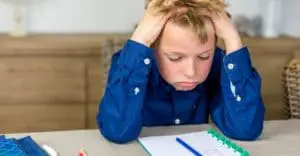
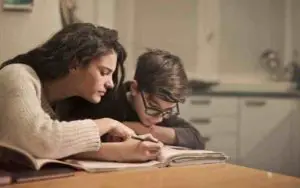
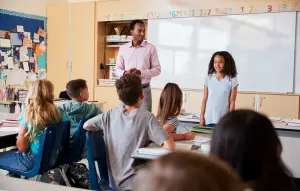
I know in middle and high school there are usually about 25 kids. Sometimes the teacher has an assistant but not always. Natalie says there is one in her math class because there are some “naughty kids.”
Haha, that is pretty funny. Thanks for sharing.
As a teacher I prefer smaller groups as for me it’s much easier to carry out my lessons without getting stressed out because of my students’ behaviour. Larger groups are more difficult to maintain for me. 🙂
I fully agree. I had a lot of hands-on stuff, so the year I had 25 students single-handedly was so hard. I made my kids help out with the prep a lot. They were as grateful as me when we only had 14 the next year and I was able to do most of the prep work myself.
My kids have 35 students per class. This article gives me something to think about
That is a huge number. But I remember in college having classes that topped 400 students in a giant building–the Lyceum! And I still got good grades. It’s possible but the teachers can only work with the students that reach out to them.
This is awesome! I remember as a kid, we were put in 40 students classes which was a lot for the teacher to handle.
I remember that too, Chad. And in college, some classes were sometimes upwards of 400 students.
This is so interesting! I always had very small classrooms going to private school, but I had no idea about the actual average numbers.
I was surprised at a lot of the numbers. And some of them still don’t make sense to me!
I’ve always had high respects for teachers because of the amount of preparation that comes with every class. Except for some professors who were unreasonable and would like to be called a “terror teacher” and those who play favorites. Plus the evaluation that you have to do afterwards. My Grandmother and her sisters were teachers, btw.
I really prefer a small teacher to student ratio. Thanks for sharing this info.
I have high respect to all teachers. When I was in grade school ratio of teachers to students is 1:63. and thinking about it, I know that it’s a very difficult task… But now, I see that these students are now excellent in their own fields. Thanks to the love and patience from our teacher before.
A lot of my college courses were like that. It does force independent learning on the students. Which means the motivated ones will thrive but the non-motivated ones will just fall behind. It is hard.
This article gives us a lot to think about, thank yoU!!
I remember when I was in grammar school, there were always about 20 kids in the classes. Then when my kids were in grammer school, they always had about 25 kids in each class. Not it seems the class sizes are a little smaller. I guess that’s one nice thing about private schools when the classes are smaller.
As I read learn and understand, we can say classroom if there is the number of students is below 25, other-wise that will be a conference, seminar …..
Oh, wow. I like that distinction. Thank you for telling me about it!
… I also agree with you that larger ratio is not bad thing and the guarantee a poorer outcome in the classroom experience….. When I was in 10th class, we were 97 pupils in one class and in college the number was big….
I feel like smaller groups would always be the better way to go, but I suppose that can be hard as well. As always, super useful information friend!
You are right that smaller groups are almost always the way to go. Thanks for sharing your thoughts. Hope you have an awesome week!
Seeing my college friends begin their teaching careers has given me some newfound respect for what teachers do. Especially now during the Covid-19 pandemic.
Yes, Jocelyn, covid has made life infinitely more difficult for school.
This was an interesting read. Whilst in school the number of students in a class was always the same, when I took private classes after graduating, to learn another language, the group was small. I could definitely notice that it was easier to learn in a small group as the students were much more engaged and it was easier for the teacher to dedicate more individual time to everyone.
That is all very true, Joanna. The teacher can actually see what each child is learning when the class is smaller.
I am all for smaller groups of students. I dn’t think over 20 people makes it a fine group to get new knowledge
My kids have about 30 kids in their class . English and maths is always done in smaller groups.Even though there are 30 kids with one teacher , I never feel the teacher is struggling, You are right , it depends on the experience of the teacher.
Thanks for sharing your experience, Priya!
Great information, very detailed. My cousin is an elementary teacher and this will be good info I’ll pass on to her
This is so interesting. Teachers are so amazing – we think people are valuing them now more than ever.
For kids, I think 10-15 students per teacher is the best ratio. This way, the student can assist the student more on their learning needs.
I see a great different in ration with my own kids than when I was in school (smaller class sizes). We do live in a rural area but I’ve always been happy with their schools and education. I’m lucky to have great students but I think we all just have to advocate for our children when they do run into problems. Great read!
Thank you, Adrienne! I’m glad your kids have had a great experience!
here in the Philippines the teacher student ratio in public schools are 1:40. I salute all the teachers around the world
Those are some hard-working teachers! My hat is off to them. ♥
I always have high regards for teachers because all great leaders passed through the hands of a good teacher.
That was super interesting never even thought about ratio and how it could impact a classroom. I’ll send this article with my friend she is teacher I am sure she will enjoy it.
i am not too surprised to see that california is tied for highest student teacher ratio. sadly because of covid-19 social distancing i doubt this will make it easy to get back to school in the autumn.
I know Virginia is trying hard to figure it out. There really aren’t any perfect answers. Just the best that we all can do. And I am hearing that many parents are going to choose to jump into official homeschooling. We can all only do our best under the circumstances. Thank you for sharing your thoughts!
I believe, the teacher must have been assessed to guarantee she can provide a quality teaching experience to the children, when the children like the teacher, they will understand better as they would always listen and pay attention to what she teaches them by heart.
Yes. In America that is done both through internship before university graduation and then later in the actual classroom.
I totally agree where you are coming from. But here in our country where lack quality teachers are felt we could not do the ratio in the classroom.
I am not a teacher but this article gives me a lot of information on how to be an effective teacher even if you have a huge numbers of students. I will definitely share this with my friends who is teaching a 30 and more numbers of students and I am sure these things will help her a lot.
I also prefer a small teacher to student ratio, and this article shared an interesting opinion of yours. Thank you for sharing!
Such an amazing post and very informative. This is definitely a great help for everybody especially school to consider and promote or I mean implement in their jurisdiction.
I heard that it’s suposedly12 to 1 but sadly here, there are cases where it’s 100 to 1.
Yes, unfortunately the averages can be very different than the real life.
I remember one of my classes in high school had 40 students and on the first day there weren’t even enough desks for all of us. 4 kids had to sit on the floor at the back for the day until the teacher could get more desks put in. One student asked to go to the guidance office and never came back so she must have asked to transfer to a different class because she didn’t want to sit on the floor.
Wow. It is already unfortunate that there were not enough desks, but putting the extra kids on the floor in the back of the room sounds like the worst possible way to deal with it. You would think they would at least get to sit up front so they could see.
When I was in collage. Our professor divided us in 2 groups.He wants a small group of students to teach so he can handle it properly and no stressed for him.
I guess, low count of group students in a class makes teacher more comfortable and less stress. When there are many students it is difficult to teach but in a small number of students it can facilitate their teaching.
Absolutely! A small kids to teacher ratio is required. I remember, my KG teacher used to handle 40 kids alone
what can you say about the general consensus by most educational institutions that show that the class size actually has little to not impact on the ability of students to retain information?
I have always heard that 12 is the ideal number but now you help out it all in perspective.
I think it depends on the area but a small class is much preferred so that a teacher can focus more on students. Not too much students in one classroom.
That’s true that the perfect teacher and student ratio is always on the hot topic of education discussion. I do think lowering the ratio helps the student but apparently there are also a lot to think about in the process. Thanks for sharing your insights. – Kncyx journeying
Teachers are definitely instrumental in our society and with our children. This was a very interesting article as I am looking to get my teaching credential.
Great tips for a smaller classroom feel. My daughter’s school seems be onboard with the group method. The school is currently running over capacity because of a new school build that has been slow and now completely halted because of Covid and the economy.
This is very interesting. In many ads, I have noticed that they the teacher student ratio is mentioned. In our class, we had 40 students in a class.
I’ve experienced being in a 30+ students classroom, and I noticed that not all students get the learning attention (though it wasn’t the students fault nor the teachers). Each kids have difference ways of learning, some can learn easily with a small crowd, etc. We need more teachers.
I’ve always done better in smaller groups. But then again, I have been homeschooled for a while haha!
And that is why homeschooling has been a great option. Smaller works better for the teacher as well as the students! So much more can get done in so much less time. Thank you for sharing, Elisha!
When I was in school in California, those numbers were spot on, we always had 24 to 26 students in each class. Some of the teachers had a student aide which definitely helped the teacher.
My numbers from Maine were spot on as well. And we had student aides as well. Teachers’ aides were not really a thing yet.
as a student in the 80s and 90s, we had the perfect ratios. and now it seems that the classes are packed to the limits. of course with covid-19 that changes things. but i know teacher aides even when i was a kid were crucial and useful. so i can only imagine they’re needed all the more now.
WOW! I was a teacher for almost 3 years (different type of classroom environment since it was mostly small groups online) so all this information is actually quite new to me. Informative x
I found it very intriguing as well, Alice.
I’m not surprised that more rural areas have larger class sizes even though they have less population as a whole. There are fewer teachers in those places, I would think.
That part was odd to me because I actually grew up in a small town and the class sizes seemed pretty average at 25-ish. The figure now is 1/3 to 1/2 of that–most likely because of the introduction of teachers’ aides.
This was a super interesting read. I love how you touched on other factors besides class size that can make a great or not so great classroom experience.
Thank you, Brianne! Since teachers can’t do much about class size, we have to think about how we are going to thrive in our circumstances.
I never knew this about ratios but it makes total sense! I’m really glad they have this ratio though because I feel like the kids will have a better experience with more instructors.
Kileen
cute & little
Yes, Kileen, the ratios are much different than they were years ago. I think schools today do have a better experience in this respect, but maybe more difficult in other areas. There will always be give and take.
Such a great resource. Thank you!
I am wondering how all the applies in the pandemic world that we are living in. California teacher ratios are not great
I would say that almost none of this applies with the current school circumstances. Parents everywhere are helping with their kids at home. But there are a few schools, mostly private, around here that are open physically. And they always have smaller ratios. That was a great thought, though!
This is such an important topic. It’s interesting too with more virtual learning
this is great information. i have to send to a few teacher friends of mine that would love this.
We remember us having around 30-40 and still wished they would change that here to a smaller number. Really beneficial to the kids to truly learn and so much more manageable even for the teachers we would think to be able to give that attention and time.
That is a huge class size. The teachers must be exhausted!
What a great resource for teachers looking to provide a better environment no matter the ratio. Thanks!
Thank you, Marian!
I definitely prefer a smaller student to teacher ratio as I believe kids need more direct attention. Great information!
I agree, Autumn!
Than you for these insights. I appreciate that you pointed out that larger ratios is not always a bad thing in education.
I think it should be 1:10. I think that is the optimal number. Also, helps teach children better.